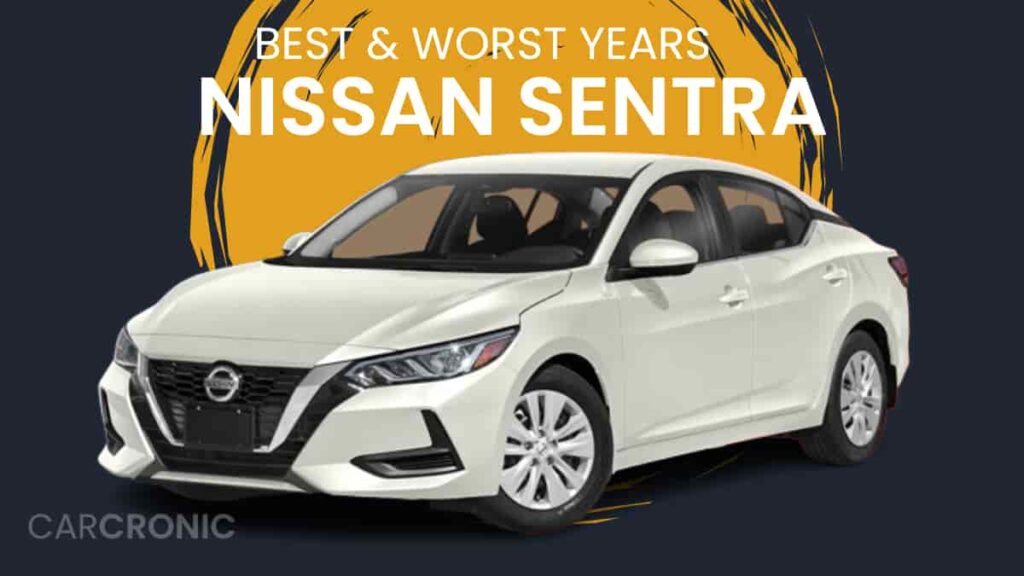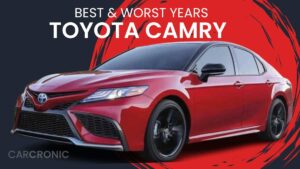Best & Worst Nissan Sentra Years: The Nissan Sentra is a very iconic car that has many generations. Here are the best years of nissan sentra for each Nissan Sentra generation and which years to avoid.

In this ultimate guide, I’ll break down all Nissan Sentra generations from 2000, highlighting the top Sentra years to pick and the worst years to avoid nissan sentra.
By using information and data from trusted sources like NHTSA, Consumer Reports, and Kelley Blue Book, I’ve meticulously analyzed data, reviews, and real owner feedback, ensuring you receive the most accurate perspective on Nissan Sentra’s best and worst years.
Whether you’re a potential buyer, a Sentra enthusiast, or just curious, I’ll highlight key factors – from Nissan Sentra problems, recalls, and nissan sentra reliability by year scores to resale values – each by year.
So, let’s dive right in.
Nissan Sentra Generations
The Nissan Sentra‘s journey began with its first generation making its debut in 1982. This model was introduced as a direct replacement for the Datsun 210. The first Sentra was applauded for its fuel efficiency, affordability, and compact design.
As Nissan’s top-selling vehicle for many years in the 1980s, the Sentra set the stage for what would become a hallmark in the compact car market.
Let’s lay down a foundation with an overview of the Sentra generations from 2000 to the present year. It’s not worth considering earlier models.
| Generation | Years |
| 5th generation (B15) | 2000-2006 |
| 6th generation (B16) | 2007-2012 |
| 7th generation (B17) | 2013-2019 |
| 8th generation (B18) | 2020-Present |
Often, generational changes become the determining factor when considering a purchase, as they give insight into the design ethos, engineering focus, and feature additions of the respective eras.
Related For You:
Best & Worst Nissan Rogue Years
Best & Worst Nissan Altima Years
Nissan Sentra Best, Neutral, and Worst Years
When determining the best and worst Nissan Sentra years, our assessments are comprehensive and based on multiple factors including but not limited to:
- Owner-reported reliability (surveys)
- Annual maintenance costs
- Safety ratings
- Consumer Reports reliability scores
- Consumer Reports owner satisfaction scores
- NHTSA recalls, investigations, and complaints
- Edmunds owner ratings
- JD Power owner ratings
- Kelley’s Blue Book (KBB) owner ratings
- VehicleHistory owner ratings
- Cars.com owner ratings
Up next, you’ll find a graph detailing combined ratings from all the sources mentioned.
Following that, we’ve summarized our findings in a table, showcasing all of Nissan Sentra’s best, neutral, and worst years.
| Generation | Best Years | Neutral Years | Worst Years |
| 5th generation (B15) | 2004 2005 2006 | N/A | 2000 2001 2002 2003 |
| 6th generation (B16) | 2009 2012 | 2007 2011 | 2008 2010 |
| 7th generation (B17) | 2017 2018 2019 | N/A | 2013 2014 2015 2016 |
| 8th generation (B18) | 2023 | 2021 2022 | 2020 |
When I mention “Neutral Years”, I’m referring to the model years that weren’t the most reliable Sentra years, but they also weren’t plagued with significant issues. They’re essentially the middle ground.
It’s essential to understand how some factors such as NHTSA recalls can negatively impact a car’s ranking. A higher number of complaints and recalls usually denotes lower reliability, while fewer complaints indicate a more dependable model.
Let’s dive into the specifics of the best, neutral, and worst years.
Best & Worst Years for Nissan Sentra 5th Generation (2000-2006)
Spanning from 2000 to 2006, the Nissan Sentra’s 5th generation was designed as a compact sedan to cater to the mid-level market which was celebrated for its affordability and functionality.
Early – 2000, 2001, 2002, and 2003 are the Nissan Sentra years to avoid while 2004, 2005, and 2006 Sentras stand out as the best Sentra years of this generation.
Best year for nissan sentra : 2004, 2005, 2006
Ignoring the age, 2004, 2005, and 2006 Sentras are the most reliable Sentras of their generation and good options to purchase.
The 2004 Sentra came with a minor facelift. The engines offered in these years were more refined, including the 1.8L I4 producing 126 hp, and the more potent 2.5L I4 for the Sentra SE-R variant, pushing out 165 hp.
Paired with these were choices between a standard 5-speed manual or a 4-speed automatic transmission, depending on the trim level. Transmission gearing and build quality were improved for the 2004–2006 Sentra SE-R Spec V which resulted in a quicker quarter-mile time of 15.2 seconds.
Modern amenities ranged from enhanced safety measures, like additional airbags and improved crumple zones, to infotainment upgrades catering to the digital age.
Fuel efficiency was commendable, with Consumer Reports marking an average of 18 mpg for the city and 36 mpg for highway driving.
The Worst Years: 2000, 2001, 2002, 2003
Considering numerous NHTSA complaints and recalls regarding engine issues, 2000, 2001, 2002, and 2003 are categorized as the worst Nissan Sentra years.
The 2000 Sentra was marred by engine problems, with many consumers reporting engine stalling at low RPMs.
It wasn’t until multiple recalls, particularly in 2001 and 2003, that Nissan addressed a recurring issue: a faulty crank position sensor affecting 2000-2003 models. This defect would trigger the “Service Engine Soon” light, hinder startup, reduce engine power, or abruptly turn off the engine – all heightening the risk of an accident.
Suspension issues further dented the reputation of the early 5th-generation models. For instance, a recall in 2001 targeted the 2000 and 2001 Sentras for issues with lower control arm bolts that could break, a problem severe enough to compromise safety on the road.
The 2002 Sentra model was particularly problematic, with the NHTSA documenting 14 recalls, the highest for this generation. Among these was a unique issue where the exhaust pipe hanger pin, in models equipped with the 2.5-liter engine, could catch and ignite road debris.
By 2003, while some of the aforementioned issues were addressed, new problems emerged, particularly with the airbag systems. These complications, combined with mechanical issues, made 2000, 2001, 2002, and 2003 the least reliable Sentra years.
See NHTSA 2000, 2001, 2002, 2003 Nissan Sentra recalls and complaints.
Best & Worst Years for Nissan Sentra 6th Generation (2007-2012)
The company’s focus on responding to previous criticisms was evident in the updated sixth generation with new design language and the variety of amenities offered. The sixth-generation Sentra performed better than previous generations with an outstanding 4.3 Kelley Blue Book score.
2009 and 2012 are the best Avalon years of this generation whereas 2007 and 2011 also remain solid options.
The Best Years: 2009, 2012
The nissan sentra best years of this generation are undeniably 2009 and 2012. In these years, Nissan demonstrated a clear intent to refine the Sentra’s attributes.
Under the hood, the models predominantly featured a 2.0L I4 engine, efficiently churning out around 140 hp. In the sportier SE-R variant, the Sentra housed a more powerful 2.5L I4 engine producing approximately 177 hp.
Transmission choices varied, offering the traditional 6-speed manual and introducing the Xtronic CVT (Continuously Variable Transmission), which aimed to provide smoother gear shifts and improved fuel efficiency.
On the technological front, 2009 and 2012 Sentras showcased advancements in both safety and entertainment sectors. Enhanced airbag systems, reinforced chassis, and an improved braking mechanism contributed to the car’s safety portfolio.
Fuel efficiency too was noteworthy, with averages of 19 mpg in the city and 35 mpg on the highway.
The Neutral Years: 2007, 2011
The 2007 and 2011 Sentra models were still reliable but saw few hiccups.
The 2007 Sentra, as the introductory year of the sixth generation, brought with it several changes, including a more spacious interior and modernized aesthetics.
However, it wasn’t completely free from problems. Some consumers noted worries with steering and airbags such as sporadic “Air Bag” light illumination. Bear in mind that these problems were persistent in 2008 and 2009 Sentras too.
By 2011, while many of the earlier problems had been addressed, a few new challenges arose. Predominantly, there were reports of engine stalling, leading to a recall in 2011 to address the Electronic Control Module malfunction and battery cable harness defects, especially pertaining to the thicker zinc coating on the terminal stud bolt.
The Worst Years: 2008, 2010
On the other hand, it is recommended to avoid 2008 and 2010 Sentras.
The 2008 model continued the airbag and steering problems of 2007 but introduced newer challenges, especially in the realms of transmission and suspension.
One prevalent issue was the rear wheel misalignment, leading to premature wear of the rear tires.
2010 Sentra compounded these issues, with many consumers reporting intermittent “Air Bag” light illuminations, a carryover problem from the previous years.
Additionally, engine stalling became more frequent, a complication that Nissan later addressed with recalls. The culmination of these issues made them some of the least reliable Nissan Sentra years.
Best & Worst Years for Nissan Sentra 7th Generation (2013-2019)
The 7th generation of the Nissan Sentra, spanning from 2013 to 2019, encapsulated a wave of design renovations, technological breakthroughs, and performance overhauls.
Post-facelift models – 2017, 2018, and 2019 are labeled as the finest Sentras while 2013, 2014, 2015, and 2016 are the Sentra years to evade in this generation.
NOTE
As the seventh-generation Sentra has considerable powertrain issues, particularly with engine and transmission, it is highly recommended to do thorough research and checks via VIN.
The Best Years: 2017, 2018, 2019
Coming to the 5th generation, Nissan Sentra’s best years were, without a doubt, the models from 2017 to 2019. By this time, Nissan had taken significant measures to rectify the grievances from the earlier models of this generation.
One of the most significant transformations lay in the powertrain, with a 1.8L DOHC I4 engine offering around 130 hp. Not only was this powertrain more efficient, but it also provided a more refined and responsive driving experience.
Paired with the Xtronic CVT, the fuel efficiency for these models was impressive, delivering an average of 21 mpg in the city and 42 mpg on the highway.
Offered in S, FE S, SV, SR, and SL trim levels, all trims were equipped with a reworked CVT except the base S model, which has an optional six-speed manual transmission.
Nissan introduced a slew of advanced safety features, including adaptive cruise control, automatic emergency braking, and blind-spot monitoring.
Additionally, infotainment systems saw integrations with Apple CarPlay and Android Auto, providing drivers and passengers alike with a seamless and enjoyable experience.
Despite having some persistent engine issues from earlier models, platforms like VehicleHistory and Cars.com signaled a more favorable reception for these years compared to their earlier counterparts, reflecting their higher quality and reliability.
The Worst Years: 2013, 2014, 2015, 2016
On the other end of the spectrum, the 2013 to 2016 Sentra years are best to avoid.
The 2013 Sentra model brought forth a staggering number of complaints, with over 600 NHTSA complaints, primarily focusing on CVT transmission.
Owners lamented over a loss of power, erratic acceleration, jerking, and in some extreme cases, complete transmission failure.
Such concerns weren’t unique to just the 2013 model, as the subsequent models up to 2016 Sentras also suffered from similar issues, with transmission troubles remaining a primary concern.
This period also witnessed airbag malfunctions, adding another layer of apprehension for potential owners.
Moreover, these years received a relatively lower rating and owner dissatisfaction from automotive platforms like Edmunds and Kelley Blue Book (KBB) with only 2.7 and 3.8 points respectively.
See NHTSA 2013, 2014, 2015, 2016 Nissan Sentra recalls and complaints.
Best & Worst Years for Nissan Sentra 8th Generation (2020-Present)
With advancements in design, technology, and performance, the latest 8th generation is a profound statement of the brand’s evolution in response to shifting market demands and learned experiences from previous models.
2020 is marked as the Nissan Sentra year to avoid due to its teething problems with the Forward Collision Avoidance system and steering.
The Best Years: 2023
As you might expect, the 2023 Sentra is the best eighth-generation Nissan Sentra model.
With three trim levels offered: S, SV, and SR, all 8th-generation models are powered by a naturally-aspirated Nissan MR engine 2.0-liter 4-cylinder gasoline direct injection engine mated to the Xtronic CVT.
The car’s design was also significantly modernized, with sharper lines, a more aggressive stance, and an interior that resonates with luxury.
J.D. Power‘s rating of 85 points for the 8th generation Sentra, with a particular emphasis on the 2023 model, is indicative of the overwhelming approval from both industry critics and consumers alike.
Fuel consumption rates, standing impressively at 22 mpg for city and 44 mpg for highway driving, further underline the model’s prowess.
The Neutral Years: 2021, 2022
The 2021 and 2022 Sentra models are also reliable and solid choices. During these years, Nissan made diligent efforts to address concerns, especially those related to the Forward Collision Avoidance (FCA) system malfunctions.
These models, while not entirely devoid of challenges, showed Nissan’s commitment to rectifying problems and gathering feedback for future improvements.
Features like improved infotainment systems, better fuel efficiency, and enhanced safety mechanisms were evident, with the IIHS Top Safety Pick award for the 2022 Sentra.
The Worst Years: 2020
However, the 2020 Sentra model might need a bit more caution.
The most reported concern revolved around the Forward Collision Avoidance system. Owners detailed instances where the FCA system malfunctioned, leading to unintended braking and posing potential risks on the road.
Steering-related issues reported by owners prompted Nissan, in 2023, to issue a recall for models from 2020 to 2022, specifically addressing a bent tie rod that could snap and compromise steering control.
Further casting shadows on the 2020 Sentra were reports of system glitches and other minor issues, painting a picture of a model year that needed more refinement.
Nissan Sentra Average Resale Values
The following graph illustrates the average resale values of Nissan Sentra models over the years, highlighting the car’s financial longevity and appeal in the secondary market.
Which Year Models of Nissan Sentra to Avoid:
Given that so many years of Nissan Sentras have been released, it’s only natural that a few mistakes would slip through the cracks. We recommend avoiding the following Nissan Sentra year models as they’ve had a litany of problems:
- Nissan Sentra 2004
- Nissan Sentra 2005
- Nissan Sentra 2008
- Nissan Sentra 2012
- Nissan Sentra 2013
- Nissan Sentra 2014
- Nissan Sentra 2015
The 2004 and 2005 year models of the Nissan Sentra are notorious for their engine problems. Blown head gaskets are widely reported for these two cars, costing around $2,000 to repair. The 2008 Sentra has had its fair share of issues with its transmission and, surprisingly, its wheels. Rusted rims have plagued a few drivers of the 2008 Sentra, and total transmission failure has also been reported a few times.
For Nissan Sentras released between 2012 and 2015, transmission failure is the number one problem. The 2013 and 2014 models are the worst Sentras manufactured today, with over a hundred complaints each. Transmission failure is a severe issue because your transmission is what sends power to your wheels, allowing you to control your steering and drive as you wish. If your transmission suddenly fails while driving at high speed, the consequences could be disastrous.
For this reason, we implore you to avoid these Nissan Sentra year models at all costs. There are so many fully functioning models available that you shouldn’t go out and buy one that could put your safety at risk.
Common Nissan Sentra Problems
Being in production for more than three decades, the Nissan has its fair share of reliability woes. Here are some of the most common Nissan Sentra problems prospective buyers should know:
- Defective brakes: Faulty brakes are a recurring issue for many Sentra owners. Some 2013 Sentra owners claimed that the brakes don’t engage until you put your foot down the pedal and it reaches the floor. The issue was tracked to the premature failure of the master brake cylinder.
- Transmission issues: Several models of the Nissan Sentra struggled with transmission issues, particularly models with continuously variable transmissions (CVTs). These transmissions are prone to losing power, leading to stalling and even failure.
- Unusual noises: Owners of the 2016 Sentra reported hearing screeching and loud howling noises while traveling at high speeds. It’s not the most concerning issue, but it does put you on the edge because you’ll wonder what’s going on with your vehicle.
- Suspension problems: According to owners of the 2017 Sentra, they kept hearing loud thumping noises from the suspension while driving at low speeds. The issue becomes even worse during cold weather. Some model years reportedly also had transmission noises like clicking, creaking, and rattling.
What are the best Nissan Sentra years to buy?
Most Nissan Sentra year models out there are excellent compact cars. At its best, the Sentra is a remarkable vehicle renowned for its safety and comfort. With many model years meeting those needs, there is little reason to purchase one that won’t satisfy you. To enjoy these exceptional experiences, we recommend you buy any of the year models below
- 1984 – 2003
- 2006
- 2007
- 2009
- 2010
- 2011
- 2016
- 2017
- 2018
- 2019
- 2020
- 2021
Nissan Sentras between 1984 and 1993 have few reports and should be solid purchases. A few 1994 Sentras have had minor issues regarding their fuel injectors, but in all, this is a pretty reliable vehicle. Models between 1995 and 1999 years have had few reports similar to the 1994 model, so you shouldn’t worry about those.
Like the 1994 Sentra, the 2000 year model also had few reports about its fuel injectors, but these issues are minor. The Sentras between 2001 and 2003 had some drivers complain that their engines gave out or they had blown head gaskets. All in all, the best Sentra models to buy are 2009 and 2017, but we’ll discuss the one that’s been on the market longer.
Should you buy a used Nissan Sentra?
What years did Nissan Sentras have transmission problems?
Reports indicate that a defect affecting 2012-2016 Sentras’ continuously variable transmissions (CVTs) can cause temporary loss of power and total failures of the CVTs. Many consumers have reported that the CVT can first cause the cars to shake, judder, stall during sudden acceleration, or completely lose power.
Which Nissan Sentra model years should I avoid buying?
It’s best to steer clear of the 2004, 2005, 2008, 2012, 2013, 2014, and 2015 Nissan Sentra models. These particular years have been reported to have significant issues, such as blown head gaskets and transmission failures, which can be costly to repair and compromise your safety on the road.
What years are good for Nissan Sentra?
Many Nissan Sentra model years are reliable and safe to purchase used. Generally, Sentras from 1984 to 2003 and 2006, 2007, 2009, 2010, 2011, and 2016 to 2021 have had fewer reported problems and are considered safer bets when buying a used Nissan Sentra.
Best & worst nissan sentra years for sale
Many Nissan Sentra model years are reliable and safe to purchase used. Generally, Sentras from 1984 to 2003 and 2006, 2007, 2009, 2010, 2011, and 2016 to 2021 have had fewer reported problems and are considered safer bets when buying a used Nissan Sentra.
Avoid The Problematic Model Years When Shopping For A Nissan Sentra
The Nissan Sentra can provide you with up to 16 years of headache-free driving so long as you avoid the 2005, 2013, and 2014 model years. From 2014 on, there have been significantly fewer reported problems; seemingly, Nissan has been improving the Sentra and offering the market a reasonably comfortable and dependable family sedan that comes loaded with all the necessary features.
Frequently Asked questions (FAQ)
What year Sentra is most reliable?
The 2021 model tops as the most reliable Nissan Sentra year.
What is the main problem with Nissan Sentra?
Transmission problems are considered the most prevalent and severe problems on a Nissan Sentra.
What is the most common problem with Nissan Sentras released between 2012 and 2015?
Transmission failure was the most prevalent issue with Nissan Sentras from 2012 to 2015. The 2013 and 2014 models are considered the worst Sentras manufactured to date, with over a hundred complaints related to transmission problems.
What is the biggest problem with the Nissan Sentra?
Most Common Nissan Sentra Problems
Transmission Problems.
Trunk Latch Problems.
Bluetooth Problems.
Conclusion
As we wrap up this guide on the Nissan Sentra best and worst years, it’s clear that newer 2017-2019 models as well as relatively old, but budget-friendly 2010-2012 Sentra models are the best Nissan Sentra models to go for.
Which Nissan Sentra model year do you believe offers the best balance between performance, reliability, and value?







